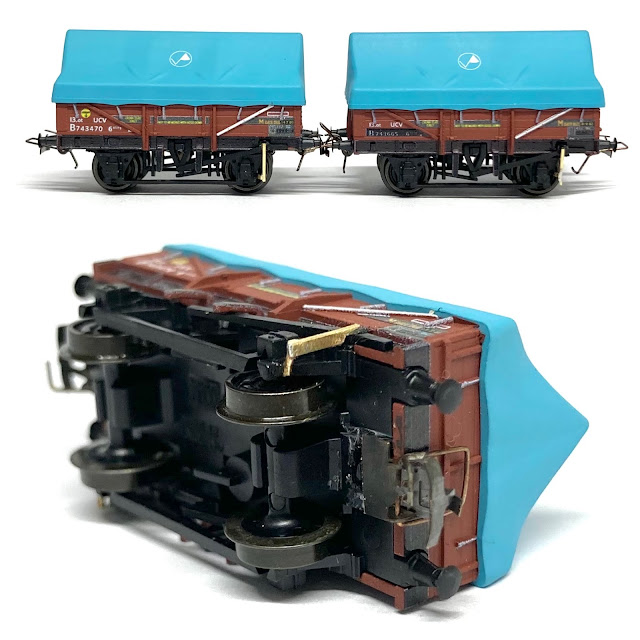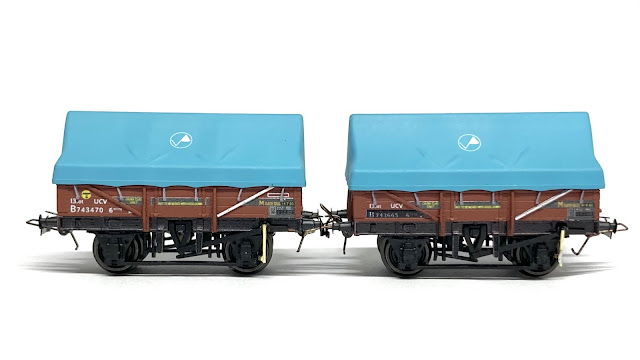Made in England - Refined in Wales…
Peco are to be applauded in this day to be able to produce quality, well designed models here in the UK. I recently bought this pair of clay hoods to see first hand the ‘current’ design and manufacturing approach to allow this to be reproducible for the price…
It was not long before I couldn’t look past that awful brake lever. This is the one design feature I hated in these ‘new’ Peco wagons when launched with the 7 plank open. Whilst I expect it’s a combination of a few design requirements (presumably ease of manufacture and mould release (the taper) and assembly (the thickness and fitting arrangement)) it is much less realistic than those employed by Farish and Revolution - perhaps even a step backwards from the original Peco one piece moulded wagon chassis of old.
They arrived (below) and I was impressed. The hoods the best I’ve seen, general colours and decoration very nice. The stepping visible in some press photos not as visible in reality, certainly not once painted and weathered. The UV printing allows a great variety and detail in the markings with no tampo tooling cost - but as a good friend mentioned, this does then require certain other decisions in design and manufacturing, some of which feel sun-optimal… But first impressions are good, these feel worth the price tag (circa £20 after retailer discounts).
 |
| As they come, with the Elsee couplings removed from the NEM-ish mount. |
This would make a nice little project - my first idea was to just ‘thin’ it down and remove the taper but because it’s not firmly fixed in the chassis it moves too much for the cut to be parallel and smooth. Plan B was to remove the ratchet part and replace it. Still, not as easy as I’d like so take your time if you follow my route…
Taking a look underside we can see the new metal tyres wheels (good) and the way the chassis is inboard of the bodywork - a design decision to allow the tooling to work under wooden or metal under frames I expect. The axle pinpoints run in a half cone and are retained, when you lift the model up, by the axle clips - these can’t be seen in most positions but are ugly… I am guessing, again, that this eases and speeds up assembly. I have left them in this instance. Note, I have removed Elsee coupling mounts - these Peco style couplings work well as they come but I noted the mounts are a bit ‘loose’ for other NEM couplings such as the Dapol Easi-shunt. Instead, I’ve fitted DG and the height works out perfectly.
This pair is destined for Penpont Dries - and I’m excited to get some weathering on them in the months ahead. However, I do keep wishing I’d not sold that rake of Farish examples a few years ago! Until next time though, more soon…
Whilst I only intend to have a pair it felt like a nice mindful exercise to make a replacement in brass. I enjoy working in this soft metal, joining with solder and filing and smoothing with familiar hand tools - but these parts are small! The nick in the end of the rectangular bar was formed on the end of a large piece before cutting off and the pin was left long before cutting down to final length right before fitting… the sizes selected just looked right, in relation to the rest of the model, rather than being chosen for scale fidelity. I expect, once painted, they’ll just blend in, something that the originals struggled to do…
Support my work
I love writing and creating material for the blog. If you enjoy what you read and engage with I would be appreciative of any donation, large or small, to help me keep it advert and restriction free. Alternatively, feel free to buy me a coffee.




Morning James. I think there's a lesson here that I need to learn, to be less judgemental and see the positives in a model, does this feel like a clay hood wagon? The overall impression of the model feels right, especially the hood and with the modifications you have made. Clayhoods have a compact feel to them thanks to the 9ft wheel base. Maybe this is more important than the brake lever arrangement? I'm looking forward to seeing them weathered and being shunted at Penpont clay works. Take care.
ReplyDeleteYes perhaps, but if they replaced the brake lever they’d appeal to a wider part of the N market. Beyond the toy collector…
DeleteOverall I think they've done a good job. I suspect over time we will see PECO really exploit the new approach, leading to further refinment. But that brake ratchet is dreadful. It reminds me of the design of police boat where there was a mix up between mm and inches...
ReplyDeleteI've not seen either in the flesh, but comparing photos of these and the new Accurascale OO ones I think that , ratchet aside, they've really captured the feel of the real thing. Not always easy with a wagon. The hoods themselves are a work of art, possibkly even better than the Accurascale ones.
Good job I've no interest in Cornish standard gauge railways. Though if ever I model our local lines in the Potteries I might have to consider some, perhaps hauled by a Warship, since apparantly they sometimes worked the Clayliner service North of Bescot. And yes, I have fallen into a rabbit hole.
Indeed - agreed James. These capture the look very well, especially or inspite of the design decisions to allow cheap and reproducible manufacturing in the UK.
DeleteHaving extolled the virtues of the Farish hood, I have discovered a snag, the wheels... I bought some clay wagons in an earlier/fictional? livery (bright red!). They have a vacuum gear underneath but spoked wheels. No worries, I can swap them out for the three hole ones that are freely available. I've just discovered that the spoked wheels have a much shorter axel length than the replacements by approx 2mm. The 3 hole wheels just won't fit! I have several packets of Farish wheels (both plain and 3 holes) which are all too long in the axel to fit between the axel boxes... I've only discovered this because I thought I'd sit down and make a start on my rake of clay hoods inspired by your article James. I'm not sure how to proceed. James F, there were a wide variety of 5 planked opens used on the clay liner, a true rabbit hole!!
ReplyDeleteMeasure over the pinpoints if you can - I’ll check a few options I have here…
DeleteTom, yes, the more I delve into the Clayliner the more interesting it gets. It a knotty problem to design a layout on the local area.
DeleteHi James, sorry for the delay in replying. The length of the spoked wheels on the Farish clay wagons is 14mm. I've measured some plain Farish coach wheels and they were 15mm. I then measured the three hole wagon wheels and they were 15.5mm! Overall a 1.5mm difference in axel length. It seems that the spoked wheels in the clay wagons must have been made specifically for those wagons? I may have to drill out the axel boxes of the wagons which is frankly not a job I'm going to be in the mood for anytime soon.
ReplyDelete14 does seem rather short… the replacements I use from Light Railway Stores are around 14.9mm
DeleteTom, it might be worth getting hold of a set of these:
Deletehttps://ebay.us/m/eQD09Q
A lot easier and less likely to damage the axle bearings than using a drill!
I'll check mine against a Farish wheelset in a bit, but I'm sure they're the right length.
Cheers, Simon.
I tried one of these in HO and it was crap, but that might have been the material the trucks were made of - which was a nylon type material. If the Farish chassis feels softer they might work - but I think, if it were me, I’d live with the spokes…
DeleteOr commission someone to design a 3 hole disc etched overlay for me…
Both the plain coach wheels and three hole wagon wheels push the chassis frames out noticeably. I have three clay wagons that were finished as OOV's which don't seem to suffer from this problem so I'm guessing the chassis moulds are the issue? I'm off to Devon for a week away now, the offending wagons have been boxed up and await a rainy day when I decide that I need more than the three hoods I currently have in OOV/UCV form. I have 13 wagons to sort out!
ReplyDeleteThese do look good, James! Not too sure about the clipped in axles, though. Not in the market for any , I'm not modelling anything related and I've probably got more N gauge wagons than I'll need for the foreseeable future!
ReplyDeleteCheers, Simon.
With the normal couplings you can’t see the axle clips, at all… they run very nicely so no complaints.
DeleteThank you for the replies James and Simon. A three hole disc wheel insert? There's a thought...
ReplyDelete